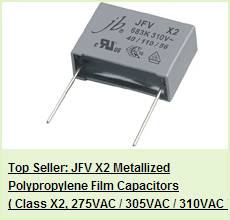jb Capacitor Standard Values
In many applications capacitors need not be specified to tight tolerance (they often need only to exceed a certain value); this is particularly true for electrolytic capacitors, which are often used for filtering and bypassing. Consequently capacitors, particularly electrolytics, often have a tolerance range of ±20% and need to be available only within E6 (or E3) series values.
| Series | Values | |||||||||||
| E3 | 1.0 | 2.2 | 4.7 | |||||||||
| E6 | 1.0 | 1.5 | 2.2 | 3.3 | 4.7 | 6.8 | ||||||
| E12 | 1.0 | 1.2 | 1.5 | 1.8 | 2.2 | 2.7 | 3.3 | 3.9 | 4.7 | 5.6 | 6.8 | 8.2 |
Other types of capacitors, e.g. ceramic, can be manufactured to tighter tolerances and are available in E12 or closer-spaced values (e.g. 47 pF, 56 pF, 68 pF).
With the introduction of S.I. submultiples of micro, nano, and pico, it became customary to specify capacitors with a number between 1 and 999 followed by farad, microfarad, nanofarad, or picofarad. While supercapacitors of up to 5,000 farads are produced, it is not usual to use kilofarad or millifarad.






0 Comment so far
Leave a reply